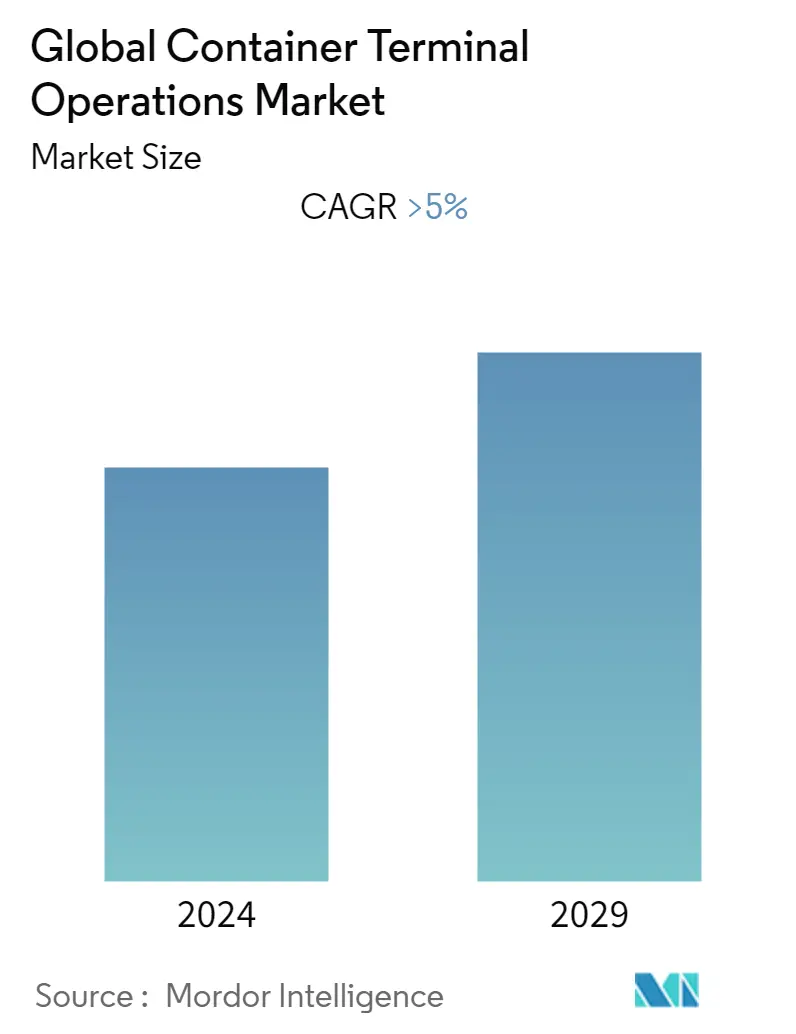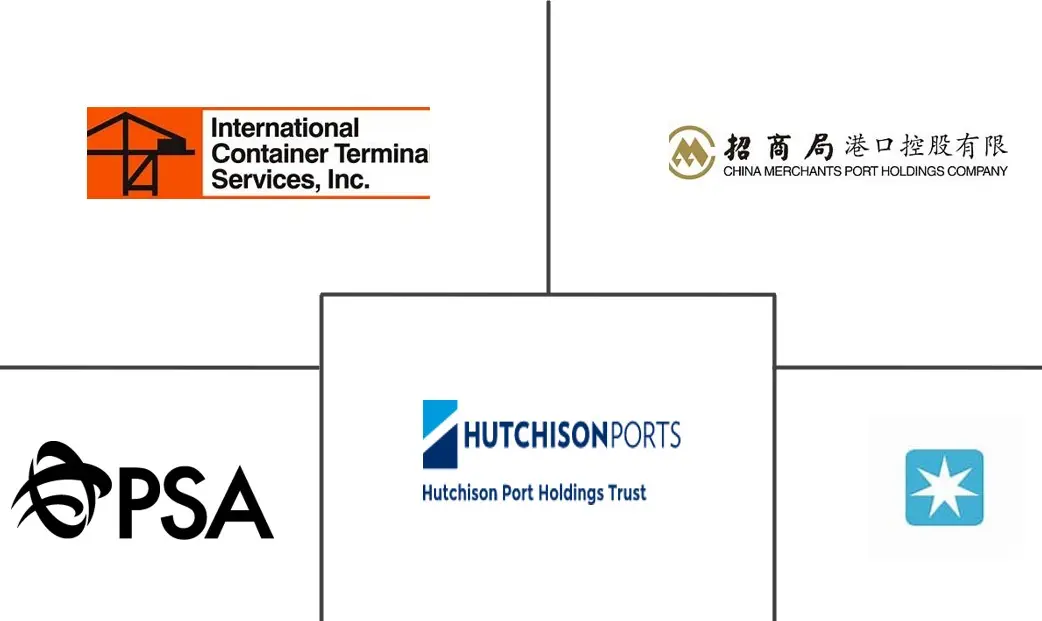Market Size of Global Container Terminal Operations Industry

| Study Period | 2020 - 2029 |
| Base Year For Estimation | 2023 |
| CAGR | 5.00 % |
| Fastest Growing Market | North America |
| Largest Market | Asia-Pacific |
| Market Concentration | Medium |
Major Players
*Disclaimer: Major Players sorted in no particular order |
Container Terminal Operations Market Analysis
The Global Container Terminal Operations Market is anticipated to register a CAGR of greater than 5% during the forecast period.
The global supply chain in the maritime industry has been facing a series of challenges since the start of the COVID-19 pandemic in early 2020. Port closures due to coronavirus outbreaks, port congestions, rising prices of bunker fuel, and problems with capacity utilization were plaguing the global marine port services industry for most of 2020 and 2021. Due to the pandemic, the volume of containers transported globally shrank by about 0.8 percent in 2020.
On the other hand, the recent spike in container freight rates turned out extremely profitable for marine port services operators who reported record high-profit margins in 2021.
Container terminal services are very complex in nature and mainly depend upon the nature of shipment and cargo. Cargo can be anything cars, merchandise, crude oil, mineral, and other types. A different set of machinery, expertise, and manpower is required to handle and manage different type of cargos. The ferry services requires different type of ports for its handling. The lack of efficiency in operations at container terminal is not desirable and led to accidents as well. So the container terminal operations should be highly efficient and flawless. Therefore container terminal operations are the core of the maritime industry.
Asia-pacific is the largest region in the market whereas North-America is the fastest growing region in the market. The Asia-pacific region is experiencing high growth in investments in new port development. India alone invested over USD 82 billion in over 400 ports. China, Singapore, Japan, and the Philippines are also focusing on new port developments and actively incorporating new technology. On the other hand, North America has a strong presence of port and terminal operating companies.
Growing maritime trade and rise in container handling services are the leading factor in boosting the container terminal operations market. The only restraint the market faces is the high cost of port and terminal operations. New opportunities are expected to arise as new technological developments are taking places such as , artificial intelligence, automation, IoT, robotics and others. In 2021 world's fully automated port began operations in China.
Container Terminal Operations Industry Segmentation
Container Terminal Operation and Cargo Handling Container terminals are designated for the handling, storage, and possibly loading or unloading of cargo into or out of containers, and where containers can be picked up, dropped off, maintained, stored, or loaded or unloaded from one mode of transport to another (that is, vessel, truck, barge, or rail). The main activity of a container terminal is the transfer of cargo units from one transport modality to another. The Global Container Terminal Operations Market is segmented By Service (Stevedoring, Cargo Handling & Transportation, and Others), By Cargo Type (Dry Cargo, Crude Oil, and Other Liquid Cargo), and By Geography (North America, Europe, Asia-Pacific, and Latin America, Middle East and Africa). The report offers market size and forecasts for Global Container Terminal Operations Market in value ( USD Billion ) for all the above segments. The report offers market size and forecasts for Global Container Terminal Operations Market in value ( USD Billion ) for all the above segments.
| By Service | |
| Stevedoring | |
| Cargo Handling & Transportation | |
| Others |
| By Cargo Type | |
| Crude Oil | |
| Dry Cargo | |
| Other Liquid Cargo |
| Geography | ||||||||||
| ||||||||||
| ||||||||||
| ||||||||||
| ||||||||||
|
Global Container Terminal Operations Market Size Summary
The container terminal operations market is poised for significant growth, driven by the increasing demand for maritime trade and advancements in technology. The industry has faced challenges due to the COVID-19 pandemic, including port closures and congestion, which initially led to a decline in container volumes. However, the subsequent rise in container freight rates has benefited operators, resulting in high-profit margins. Container terminal operations are crucial to the maritime industry, requiring efficient handling of diverse cargo types using specialized machinery and expertise. The Asia-Pacific region leads in market size, with substantial investments in new port developments, while North America is experiencing rapid growth. The market is characterized by a mix of local and international players, with technological innovations such as automation and IoT expected to create new opportunities.
The global container terminal operations market is expected to expand as maritime trade continues to grow, with Asia-Pacific ports handling a significant portion of the world's containerized cargo. The market's growth is supported by the increasing volume of freight transported by sea, which is a vital component of global trade. Despite the high costs associated with port operations, the market is anticipated to show positive growth due to the rise in seaborne trade and the expansion of developing economies. Key players in the market, such as A.P. Moller - Maersk and International Container Terminal Services Inc, are actively expanding their operations to enhance connectivity and improve supply chain resilience. The market's fragmented nature presents opportunities for new entrants, further driving growth during the forecast period.
Global Container Terminal Operations Market Size - Table of Contents
-
1. MARKET DYNAMICS
-
1.1 Market Overview
-
1.2 Market Drivers
-
1.3 Market Restraints
-
1.4 Value Chain / Supply Chain Analysis
-
1.5 Porters 5 Force Analysis
-
1.5.1 Threat of New Entrants
-
1.5.2 Bargaining Power of Buyers/Consumers
-
1.5.3 Bargaining Power of Suppliers
-
1.5.4 Threat of Substitute Products
-
1.5.5 Intensity of Competitive Rivalry
-
-
1.6 PESTLE Analysis
-
1.7 Technological Advancements In The Market
-
1.8 Impact Of Covid -19 On The Market
-
-
2. MARKET SEGMENTATION
-
2.1 By Service
-
2.1.1 Stevedoring
-
2.1.2 Cargo Handling & Transportation
-
2.1.3 Others
-
-
2.2 By Cargo Type
-
2.2.1 Crude Oil
-
2.2.2 Dry Cargo
-
2.2.3 Other Liquid Cargo
-
-
2.3 Geography
-
2.3.1 North America
-
2.3.1.1 US
-
2.3.1.2 Canada
-
2.3.1.3 Mexico
-
-
2.3.2 Europe
-
2.3.2.1 Germany
-
2.3.2.2 UK
-
2.3.2.3 France
-
2.3.2.4 Russia
-
2.3.2.5 Spain
-
2.3.2.6 Rest of Europe
-
-
2.3.3 Asia Pacific
-
2.3.3.1 India
-
2.3.3.2 China
-
2.3.3.3 Japan
-
2.3.3.4 Singapore
-
2.3.3.5 Malaysia
-
2.3.3.6 South Korea
-
2.3.3.7 Australia
-
2.3.3.8 Rest Of Asia Pacific
-
-
2.3.4 South America
-
2.3.4.1 Brazil
-
2.3.4.2 Argentina
-
2.3.4.3 Rest of South America
-
-
2.3.5 Middle East & Africa
-
2.3.5.1 UAE
-
2.3.5.2 Saudi Arabia
-
2.3.5.3 South Africa
-
2.3.5.4 Rest of Middle East & Africa
-
-
-
Global Container Terminal Operations Market Size FAQs
What is the current Global Container Terminal Operations Market size?
The Global Container Terminal Operations Market is projected to register a CAGR of greater than 5% during the forecast period (2024-2029)
Who are the key players in Global Container Terminal Operations Market?
A.P. Moller - Maersk , International Container Terminal Services Inc, PSA International Pte. Ltd., China Merchants Port Holdings Co. Ltd and Hutchison Port Holdings Trust are the major companies operating in the Global Container Terminal Operations Market.

